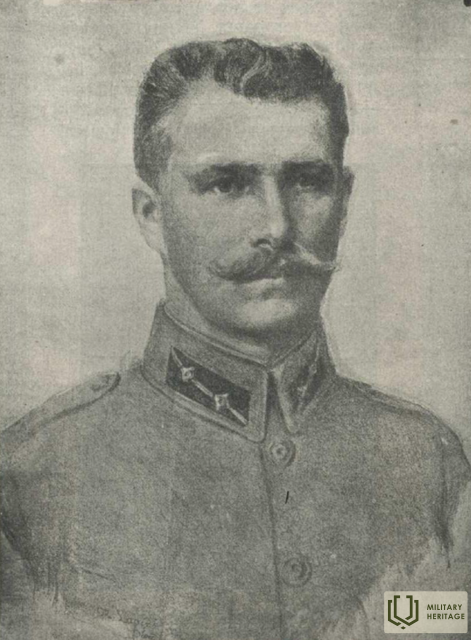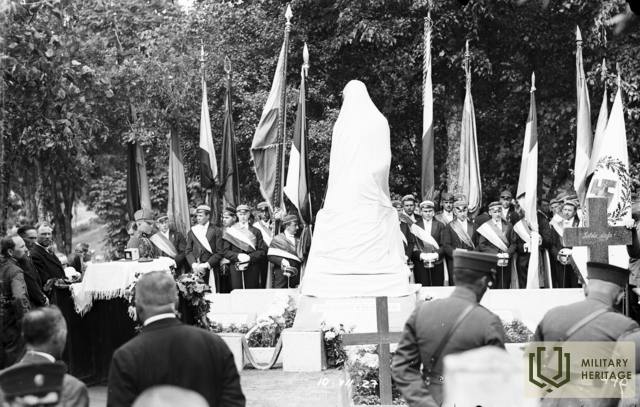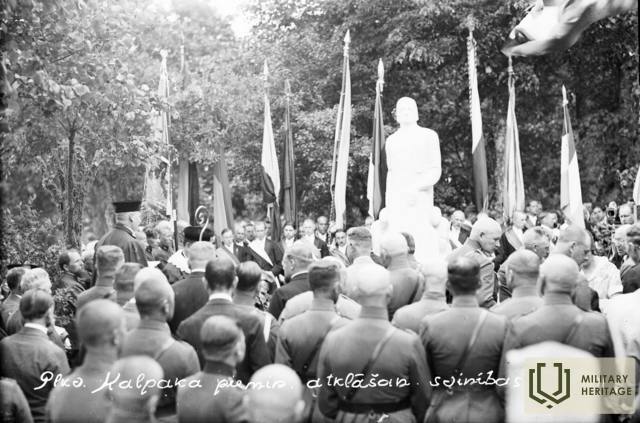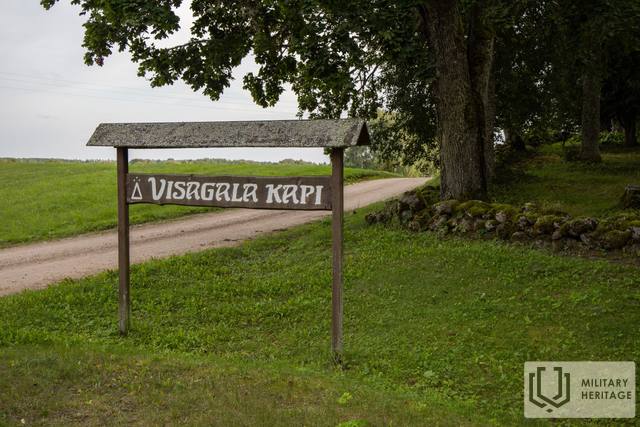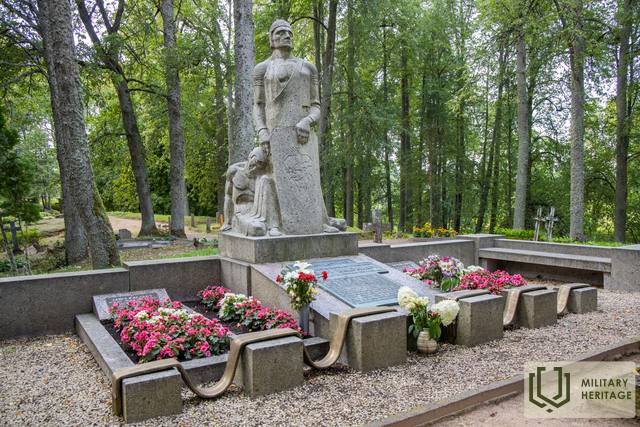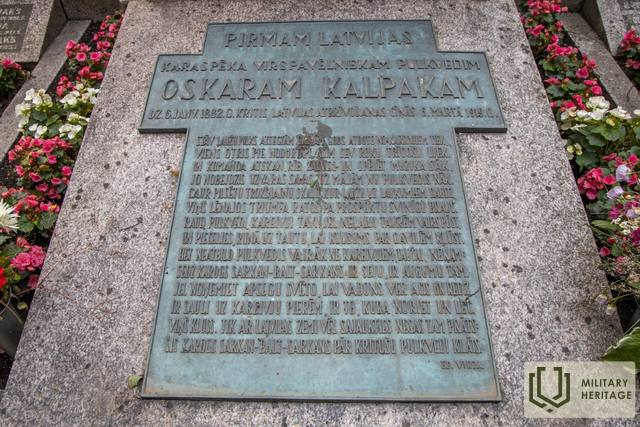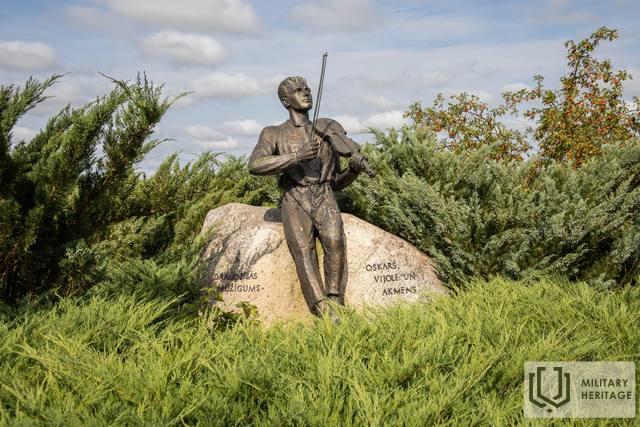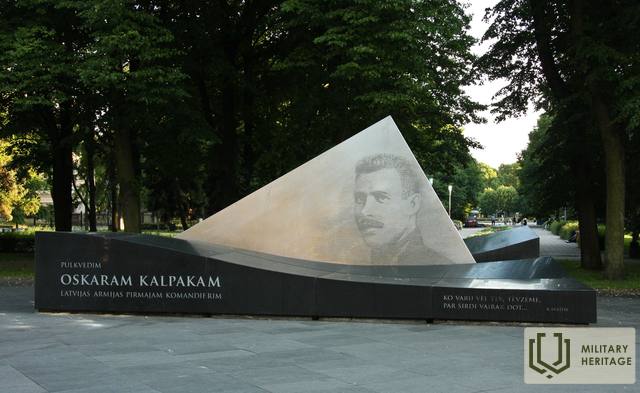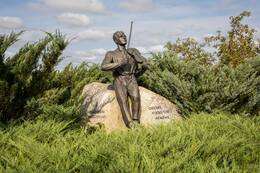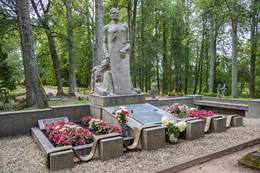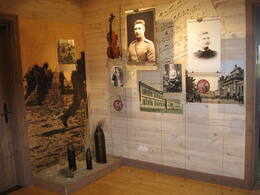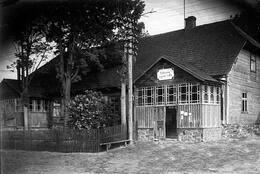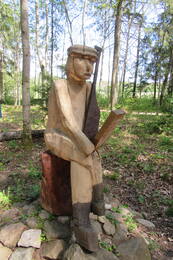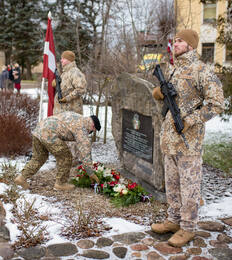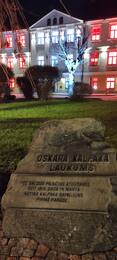Oskarui Kalpakui atminti
Oskaro Kalpako atminimas saugomas daug kur – tai liudija jo gimtasis Liepsalu namas, paminklas Visagalos kapinėse, atminimo renginiai ir gražūs Kovo 6-osios koncertai, Meirānu Kalpako pagrindinė mokykla, gatvės Lubanoje, Madonoje ir kituose miestuose ir toliau. Bet šiame straipsnyje – apie Oskaro Kalpako atminimo išsaugojimą gimtinėje XX amžiaus 2–3 dešimtmetyje. metų.
Edvardas Virza apie Oskaro Kalpako vaikystę
Liepsalose gimė Oskars Kalpaks (1882 m. sausio 6 d.–1919 m. kovo 6 d.), o poetas Edvardas Virza savo vaikystę apibūdina taip:
“Oskars Kalpaks grew up in his family home as a resourceful, lively and healthy boy. What he first saw around him was an active rural life, slow, stubborn and persistent. The attractiveness of the surrounding nature, the poetic and ancient Aiviekste, the spruce forests that hissed like great waters during a storm and dried up like the laments of a tormented spirit in a light wind, the tales and stories, the humming of the cart on long winter evenings, did not allow the boy’s soul to become dull. He was often seen sitting on a large stone on the edge of the Sauki swamp and watching the clouds as they, carried by the wind and pierced by the golden spears of the west, rushed over the forest edges. Here, a few years later, when he entered the ministry school, he loved to play the violin, extracting all kinds of melodies from it. This stone, the dream of his childhood and youth "The pedestal was to become the pedestal of his eternal glory a few decades later."
Mokykla pavadinta Kalpako vardu.
Pirmoji O. Kalpako mokykla buvo Visagaloje. Jo giminaitis ir vaikystės draugas Otto Rutkis apie savo mokyklos laikus rašė 1939 m. laikraštyje „Brīvā žemė“. 2001 m. jis sakė: „Kai mes augome, mūsų tėveliai turėjo mažai pinigų, bet daug dirbo. Kai pradėjome lankyti mokyklą, Kalpaks buvo didžiausias išdykęs berniukas pirmoje klasėje, nes puikiai sekėsi visais savo mokslais, o jau buvo ryžtingas ugdė visų pagarbą ir išliko prižiūrėtoja visus mokslo metus“.
Visagalos mokykla 1925/1926 m. mokslo metais persikėlė į Meirāni. Pagal archyvinę medžiagą, 1928 m. spalio 26 d. eilinio Meiranų parapijos tarybos posėdžio darbotvarkėje pirmą kartą buvo įtrauktas Meiranų 6 klasės pradžios mokyklos pavadinimo keitimo klausimas. Posėdžiui pirmininkavo Tarybos pirmininkas Ernestas Draguns. Prašymas dėl pavadinimo keitimo gautas iš mokyklos tarybos. Atsižvelgdama į tai, taip pat išklausiusi kelių visuomeninių organizacijų nuomones, parapijos taryba vienbalsiai nutarė savo 6 klasių pradžios mokyklą pervadinti į Pirmosios Latvijos kariuomenės vyriausiojo vado pulkininko O. Kalpako 6 klasės pradinę mokyklą. Už tai balsavo 14 susirinkusių parapijos tarybos narių (Augusts Kamols nedalyvavo): Jānis Akmens, Jānis Birziņš, Ernests Baltais, Arvids Drinkens, Oskars Kalve, Eduards Kalpaks, Alberts Kalpaks, Pēteris Kalve, Kārlis Pētersons, Alfreds Rudzons, Otto Rutkis, Jānis Sams.
Tačiau mokyklos pavadinimo keitimas neįvyko taip greitai. Madonos apskrities mokyklų valdyba ilgojo pavadinimo nepasirodė tinkama ir paprašė Savivaldybės departamento sutikimo mokyklą pavadinti Meirāno Kalpako 6-ąja pradine mokykla. 1929 m. vasario 26 d. Vidaus reikalų ministerijos mėnesiniame leidinyje buvo išspausdintas straipsnis, kuriame bendrai nurodoma „Į ką reikia atkreipti dėmesį keičiant mokyklų pavadinimus“, minima Meiranų mokykla. Departamentas pranešė, kad pulkininko Kalpako atminimo pagerbimui prieštarauti negali būti, tačiau atkreipė dėmesį, kad kadangi mokykla yra parapijai priklausantis nekilnojamasis turtas, apskrities valdyba turi nuspręsti, ar mokyklos, kaip nekilnojamojo turto, pavadinimo pakeitimas turi būti registruojamas žemės registre, ar jis bus taikomas tik mokyklai kaip ugdymo įstaigai. Norintys mokyklą pervadinti į nekilnojamąjį turtą, reikia prašyti Vidaus reikalų ministro sutikimo, pirmiausia ministerijai atsiunčiant parapijų ir rajonų vyriausybių sprendimus bei išrašus iš žemės registrų dėl esamo mokyklos pavadinimo.
Madonos apskrities valdyba 1929 m. kovo 27 d. eiliniame posėdyje (valdybos pirmininkas A. Mūrnieks ir valdybos nariai A. Reipoltas, T. Stange, J. Jansonas ir A. Spalviņš), reaguodama į kovo 13 d į mokyklos nekilnojamojo turto pervadinimą pulkininko Kalpako vardu. Ir taip su 1929/1930 m. Dešimtajame dešimtmetyje mokykla vadinosi Meiranų (parapijos) Kalpako 6 klasių pradžios mokykla.
Muziejinės vertybės Meirānu Kalpako pagrindinėje mokykloje
Mokykloje veikė ir Oskaro Kalpako muziejus, tiksliau – memorialinis kambarys ar kampelis. Mokykloje buvo suolas, kuriame Kalpakas sėdėjo pirmaisiais metais senojoje Visagalos pagrindinėje mokykloje. 1940 m. pradžioje laikraštyje „Daugavas Vēstnesis“ publikuotas paveikslas leidžia daryti detalesnes išvadas apie mokyklos memorialiniame kampelyje esančius daiktus: Oskaro Kalpako nuotrauka, įrėminta ir papuošta žalumynų girliandomis ir tikriausiai raudonais, baltais ir raudonais kaspinais, daugybė kitų nuotraukų, du šautuvai ir du kariuomenės paltai, taip pat kaip šalmas. Atminimo kampelyje taip pat buvo iki paminklo atidengimo ant Oskaro Kalpako kapo buvęs antkapinis paminklas ir galbūt juostos iš perlaidojimo metu padėtų vainikų. Kažkas buvo rodoma ir vitrinoje už stiklo, bet kai kurių dalykų tikrai nepavyksta iššifruoti. Madonos muziejaus kolekcijoje esantis O. Kalpako memorialinio kampelio vaizdas leidžia susidaryti vaizdą apie fotografijų turinį. Memorialo kampelyje yra nuotraukos, kuriose užfiksuotas paminklo pamato akmuo Visagalos kapinėse, taip pat paminklo atidengimo ir paminklo atidengimo Airytėje nuotraukų serija. Yra ir kitų nuotraukų, apie kurias tiksliai pasakyti, kas jose pavaizduota, neįmanoma. Ant kapo esančioje atminimo lentoje parašyta: „Pirmajam Latvijos kariuomenės vadui pulkininkui Oskarui Kalpakui, 1919 m. kovo 6 d. kritusiam Latvijos išsivadavimo mūšiuose prie Airytės“. Ši atminimo lenta iki šiol saugoma Meirānu Kalpako pagrindinėje mokykloje. Iki paminklo atidengimo lenta kapinėse stovėjo ant pagrindo su tekstu: „Pulkininko O. Kalpako paminklo pamatas 1925.VI.14“.
Pamatinio akmens dedikacija O. Kalpako paminklui
1925 m. birželio 14 d. Visagalos kapinėse pašventintas Oskaro Kalpako paminklo pamatinis akmuo. Spauda apie tai rašė: „Birželio 14-oji buvo puiki šventė. Iš ryto Visagalos kapinėse Meiranuose buvo pašventintas mūsų tautinio didvyrio Kalpako kapas, kuriame dalyvavo Ministras Pirmininkas, Vidaus reikalų ministras su žmona ir generolas Balodis. Meiraniečiai taip pat šiltai ir šiltai sutiko į Balio miestelio svečius , kur vyko Madonos apskrities gvardijos pulko paradas Ministras Pirmininkas Celmiņš priėmė eiseną ir apdovanojo geriausius šaulius.
Tarp apdovanojimų buvo užsienio reikalų ministras Meierovics ir vienas vidaus reikalų ministras E. Laimiņš. Po parado rašytoja Saulietė skaitė paskaitą „apie ką mes, latviai, turime saugoti“ ir pabrėžė, kad ypač turime saugoti savo protėvių dorybes. Po rečitalio sekė smuikininkės Taubės ir fortepijonininko Osio koncertas. Šventė baigėsi banketu ir baliu. Tačiau kiti leidiniai patikslina šį įvykį, informuodami, kad paminklo pamatinis akmuo buvo pašventintas O apie šį įvykį G. Mīlbergas „Aizzragtoje“ rašo ne taip saldžiai: „Svečių garbei buvo surengta bendra vakarienė, į kurią Madonos miestelio tėvai manė, kad galima pakviesti iš viso sargybinio pulko, apytiksliai. 400 dalyvių, tik pulko vadas ir adjutantas. Dėl to susiklostė tragikomiška situacija: sakydavo kalbas, sveikindavo gynėjus, išgerdavo truputį alaus iš 1-ojo bataliono gynėjų iškovotos garbės taurės, bet gynėjai to negirdėjo ir nematė: blaškėsi po kaimą, ar rūgtu protu važiavo namo... Garbės svečiai taip pat jautėsi gana nejaukiai.
Nuo Visagalos piliakalnio
Žinoma, dėmesio vertas skulptoriaus Kārlio Zāles ir akmentašio Arnoldo Dzirkalio paminklo atidengimas Visagalos kapinėse 1927 m. liepos 10 d. 4 dešimtmetyje buvo populiaru keliauti į įvairias istoriškai reikšmingas Latvijos vietas, išgyvenant tai kaip piligriminę kelionę. Po paminklo O. Kalpakui atidengimo tokiomis vietomis tapo ir Meiranai, Visagalos kapinės, Kalpako mokykla, o keliautojai dažnai užsukdavo į Liepsalą. Interesting travel descriptions of a visit to Kalpaks' homeland can be read in several newspapers from the 1930s: "From Meirānu station, the road first winds through still snowy fields to the Visagala cemetery. There the colonel rests in eternal peace. There an old alley indicates that the colonel was also taken to his final resting place along it. The cemetery itself is located on a long, small hill with two mounds. On one mound, the Kalpaks gravestone, sculpted in the image of an ancient soldier, can be seen. From the Visagala castle mound, a wide area is visible: forests, swamps and snow-covered rural villages. Right next to it is the Liepu hill, which is also called the Gallows hill. Behind the cemetery to the left is the church hill. Also towards Aiviekste, the old Visagala elementary school building is visible, where Colonel Kalpaks received his first education. A monument has also been created here from a large stone from the Sauka bog."
Keliautojai Kalpako pagrindinėje mokykloje
Kita kelionė pasakoja apie tai, ką jis pamatė mokykloje: „Jau labai tamsus ir aštrus rytas, man į akis, kai išlipu į Meirānu. Ryškios šviesos šviečia namo languose ant kalvos. Aš einu ten.„ Tai yra „Kalpakas“ pradinė mokykla, kuriam netaikoma mokykla, kuri neturi mūsų, nesvarbu, koks yra jo pradinė mokykla , Drinkēns, kuriam patikėta auginti šios mokyklos mokinius, didvyrišką Kalpako dvasią, maloniai atidaro duris ir suteikia velioniui svečiui vietą pasilikti po šios puikios mokyklos sparną. Ryški mokykla. Su didele pagarba Robertsas man parodo ir pasakoja apie Kalpako smuiką, kuris dabar yra jo žinioje.
Ryte mokyklos direktorius A. Drinkėnas parodo kambarį su Kalpako memorialiniu kampeliu. "Didžioji dalis jo daiktų yra karo muziejuje. Kalpaks priklauso visai latvių tautai. Tačiau turime galimybę būti šalia jo gyvenimo ir poilsio vietos, puoselėti ir puoselėti jo atminimą, pagerbti jo vardą", – sako mokyklos direktorius. Tada per pievas ir miškus palei Aiviekstės upės pakrantes mane veda į Kalpako gimtąją sodybą – Liepsalą.
Apie Liepsalą
Oskaro brolis Kārlis su šeima ūkininkavo Liepsaloje. Vieno keliautojo aprašyme skaitome: "Čia yra vietovė, kurioje gausu didelių miškų ir pelkių, tarp jų yra ir senų, ir naujų namų. Kai proskynoje paliekame storą eglių sankaupą, ant mažos kalvos matome geltonai nudažytą namą su tvarkingais ūkiniais pastatais. Aplink yra miškai gyveno ant sienos tarp langų – 3 dideli antkapiai: iš vienos pusės – jo tėvas, o iš kitos – jo mama, kur susėdome prie krosnies, kur kažkada stovėjo ponia Kārlis Kalpaks. Grįžęs iš Rusijos planavo visam laikui likti Liepsaloje. Jis nuėjo ir padėjo visiems, kur tik galėjo. Bet vieną dieną jis parvažiavo namo iš Lubanos, toks liūdnas ir susimąstęs. Jis pasakė tėvui, kad važiuoja į Rygą padėti Latvijos valstybei. Mama paruošė ir žadėjo šiltus drabužius, bet jis visko atsisakė ir pasakė: „Kas bus namuose, tas ir pasiliks, bet ką pasiims, Dievas žino, kur atsidurs!“ Kitą rytą jo tėvas pakinko arklį ir nuvežė į Madonos stotį. – Tai buvo paskutinis kartas, kai jį matėme.
Keliautojas Liepsaloje susitiko ir su akmentašiu Arnoldu Dzirkaliu: „Čia apsistoja ir skulptorius Dzirkalis, kurdamas pulkininko Kalpako biustą. Pradeda ryškėti pasakojimai apie Kalpako vaikystę ir jaunystę. Mano brolis pasakoja, kad pulkininkas savo gyvenimą grindė pasiaukojimu ir darbu. Kai lankėmės Liepsaloje, jis visada padėdavo sutvarkyti visus Liepsalo namus daiktai jau išdalinti muziejams.“ Liepsaloje tebėra pulkininko smuikas ir sukauptos natos.
Dar vienas keliautojas Liepsaloje buvo, kai dar sninga: „Tikras latviškas namas. Didelis paprastumas, grožis ir nuoširdumas. Sode vingiuojančiajam linksta apsnigtos Kalpakų pasodintų lazdynų ir kitų medžių šakos. Maloni Liepsalos šeimininkė, ponios Kalpaks brolis Kārlis, priima svečius, o šeimininkas Kārlis pasiklauso. Jis atvežė grūdus į Meiranų stotį. Apie savo brolį jis sako: „Oskaras ragino mus visus ir kvietė būti pasiruošusiems bet kurią akimirką stoti į kovotojų gretas. Išeidami jie sakė: „Broli, tu turėtum ateiti su manimi, bet kadangi esi silpnesnis ir negali išeiti iš namų be šeimininko, tai geriau tau pasilikti čia“. Kai persikraustydavo namo, jis visada būdavo šalia, kur ir kada reikėdavo surengti sniego gniūžtes ar kitus žaidimus. Jis turėjo didelę jėgą ir judrumą. Kai užaugo, kažkada dirbo mūsų namuose mūrininkų kalkių maišytuvu. Jam buvo mokama 3 rubliai per dieną, o kitiems tik 2 su puse rublio. „Vergas nebijojo jokio darbo, neturėjo „paprastų ir subtilių“ darbų.
Antri Liepsaloje ir Gaigaliešyje
Keliautojai iš Meiranų pusės sustoja ir kitose vietose: „Be to, mano kelias veda į kitą Liepsalą, kur gyvena artimas Kalpako giminaitis, amžininkas ir vaikystės draugas Otto Rutkis. Sėdame prie stalo, ant kurio kadaise sėdėjo Kalpakas. Tuo metu jis aistringa kalba ragino visus susirinkusius šeimininkus kovoti.
Kalpako pusbrolis Albertas Kalpaks gyveno Gaigaliešyje. He tells about Oskars Kalpaks: “When Oskars came to our village, he was helpful to everyone. He would go with us to the forest to carry logs and break stones. He would lift a 14-foot-long and thick log like a sledgehammer. When he came from Russia, he was weak, but he still said happily: “It’s nothing, Latvian bread will make me better.”” And then the traveler went on: “Then across Aiviekste — along the linden and oak alley to the place where Kalpaks rests. We slowly climb the quiet cemetery hill. There, on the highest hill, stands the Kalpaks monument. On the grave are wreaths of pine and lingonberries. A gray boulder, shaped by the hand of a sculptor. In the distance, the blue Lubāna stream shines, in the distance the waters of Aiviekste flow quietly under the ice, but here, in silence under the stone monument, the Latvian freedom fighter Oskars Kalpaks rests in eternal peace.”
Atminimo renginiai Meirani mieste
Oskaro Kalpako atminimo renginiai buvo organizuojami kovo 6, gegužės 15, lapkričio 18 dienomis ir kitomis reikšmingomis datomis. 1937 m. kovo 6 d. Meiranų gvardijos skyrius ir Latvijos aeroklubo Meiranų filialas (kuris tądien buvo atidarytas) surengė atminimo pamaldas Visagalos kapinėse, o vėliau atminimo pamaldos ir teatro spektaklis vyko Meiranų bendruomenės centre. 1940 metų kovo pradžioje į Visagalos kapines iškilmingai atvyko dešimt pulkininko I. Kūlio vadovaujamų karininkų, taip pat sargybiniai iš Madonos. Vakare iškilmės tęsėsi Meirānu Kalpako pagrindinėje mokykloje.
O. Kalpako tėviškę aplankė ir Majsuplēcių šeimos nariai. 1939 metais Meiranų valsčiaus Ozolinių stovykloje veikė 27 Rygos 2-osios miesto gimnazijos mažojo pulko nariai su 4 vadovais. Dirbo žemės ūkio darbus – mergaitės retino pašarines ropes ir burokėlius, dirbo šieną. Berniukai taisė tvoras ir atliko kitus darbus. Tačiau laisvą dieną – sekmadienį – būrelio nariai surengė pamaldas prie Kalpako kapo, aplankė pirmąją mokyklą ir gimtinę.
Iš „Madonos Žinių“ sužinome, kad buvo įkurtas Kalpakų poilsio vietos gražinimo komitetas, kuris daugiausia dėmesio skirs kapinių sutvarkymui.1940 m. 2019 metais buvo numatyta ne tik didžiuotis gražiai tvarkoma O. Kalpako poilsio vieta, bet, atsižvelgiant į tai, kad pačios kapinės nėra pavyzdinės, atlikti nemažai patobulinimų. Numatyta koplyčią atstatyti ir šalia plento įrengti vartus, taip pat kapines pervadinti Kalpako vardu. Bet – Kalpako vardas vėl pradėtas gerbti nepraėjus nė pusei amžiaus.
"Lubāna. Kitas šimtas", 2020 m.
LNA Latvijos valstybės istorijos archyvas, F.380, A.1., L.406
Madonos kraštotyros ir meno muziejus (MNM 38361)
Bebris, Raimondas. Po piligriminės kelionės į plk. Kalpako paminklas. Kareivis. 1927 08 07.
Tėvynėje. Latvijos kareivis. 1925 11 27.
Papuošsiu Kalpako poilsio vietą. Madonos naujienos. Nr.21. 1940 06 06.
Kalpako gimtinėje – Meirāniuose. Poilsis. Nr. 696. 1938 03 04.
Kamols, A. Meirānu parapija seniau ir dabar. Parapijos gyvenimas.1938 11 15.
Į ką reikėtų atsižvelgti keičiant mokyklų pavadinimus? Vidaus reikalų ministerijos leidinys. Nr. 280. 1929 02 26.
LL policijos leidinys. Nr. 46. 1925 06 16.
Lubanų klanų mažos grupės nariai. Laisva Žemė. Nr. 146. 1939 07 04.
Mīlbergs, G. Ką jie žada ir ką duoda. Apsaugininkas. Nr. 7. 1925 07 01.
OZ pirmosios Latvijos armijos vyriausiojo vado tėvynėje. Savaitė.1925 07 24.
Pulkininkas Kalpakas išgelbėja visą diviziją. Dauguvos leidinys. Nr. 54. 1940 03 06.
Rn. Kalpako tėvynėje. Laisva Žemė. 1939 03 03.
Šventės prie pulkininko Kalpako kapo Meirane. Latvijos kareivis.1925.06.16.
VŽ 1938. Pulkininko Kalpako tėvynėje. Rytas. Nr.63, 04.03.
Žiogų diena Kuse. Madonos naujienos. Nr.21. 1940 06 06.
Susijusi laiko juosta
Susijusios temos
Susijusios vietos
The birthplace of Colonel Oskars Kalpaks “Liepsalas” and the final resting place in Visagals cemetery
The Colonel Oskars Kalpaks family memorial in Liepsalas is located in the area between Madona and Lake Lubāns. Liepsalas is Kalpaks’ childhood home. The memorial site was established here in 1997 based on the ideas and using the resources of the colonel’s niece, Ārija Kalpaks-Grundmane (1922-2006). The site consists of various environmental objects and stone sculptures with a symbolic meaning, signifying Latvian ethical and patriotic values. The largest building houses an exhibit dedicated to the history of the Latvian War of Independence and the 22 years of Latvian freedom (1918-1940). Located in the Visagals graveyard, the monument to Oskars Kalpaks, created by Kārlis Zāle and Arnolds Dzirkals, was unveiled in 1927. The monument consists of a composition of three figures, in the centre of which is an ancient Latvian warrior holding a shield and a sword, with a falling soldier on each side. Placed obliquely on a granite base, a bronze plaque at the foot of the sculptural group contains engraved text, including a poem, dedicated to Kalpaks, by Edvards Virza. Oskars Kalpaks died on 6 March 1919 near Airītes, by the road from Skrunda to Saldus.
The last resting place of Colonel Oskars Kalpaks
Located in Visagala Cemetery, Madona district
On July 10, 1927, a monument made by Kārlis Zāle and Arnolds Dzirkaļs was unveiled to Oskars Kalpaks - a composition of three figures, in the center of which is an ancient Latvian warrior with a shield and a sword in his hand, but on both sides is a wielding soldier. At the foot of the sculptural group, a bronze plaque is placed on the granite base, with a text engraved on it, which also includes a poem by Edward Virza dedicated to Kalpak.
Oskars Kalpaks fell in 1919. On March 6, near "Airīte", on the side of Skrunda - Saldus road, on September 18, his remains were transferred from the northern cemetery of Liepāja to the family cemetery in Visagala.
The monument was unveiled by General J. Balodis, Chairman of the Monument Committee of Colonel O. Kalpaks, with the participation of the then President G. Zemgale, Prime Minister M. Skujenieks, Speaker of the Saeima P. Kalniņš, Minister of War R. Bangerskim and K. Ulmanis. The foundation stone of the monument was laid on June 19, 1925. The stone for the monument is taken from the colonel's native house in Siena swamp, O. Kalpaks loved to play the violin on this stone as a child.
Oskaro Kalpako muziejus ir memorialinė vieta „Airītes“
Oskaro Kalpako muziejus ir memorialinė vieta „Airītes“ yra tarp Saldaus ir Skrundos, netoli greitkelio A9. Parodoje pateikiama išsami informacija apie pulkininką Oskarą Kalpaką ir jo batalioną, taip pat pristatoma Latvijos nacionalinės armijos ir memorialinės vietos „Airītes“ istorija. Parodoje pulkininką Oskarą Kalpaką pristatoma kaip asmenybę, kaip karį ir kaip kovotoją už Latvijos nepriklausomybę. Parodoje taip pat yra garso įrašų latvių, anglų ir vokiečių kalbomis. Juose pabrėžiama 1918/1919 m. istorinių įvykių svarba saugant Latvijos valstybingumą. Muziejaus pastatas yra restauruotas.
Įėjimas nemokamas; ekskursija su gidu – mokama. Komplekse yra poilsio zona, parkas, kliūčių ruožas, galima lankyti įvairius užsiėmimus, yra seminarų salė iki 30 žmonių.
Memorial plaques to the Lubanians who died in the First World War and the War of Independence in the Lubana Lutheran Church
Located in Lubāna, Baznīcas Street 1, in the Lutheran Church.
A white marble memorial plaque to Colonel Oskars Kalpaks was erected in the church of Lubāna during the interwar period. "born Hugo Celmins.
Materials about Oskars Kalpaks and Hugo Celmiņš can be seen on a daily basis in the exposition of the Lubāna Cultural Heritage and Tourism Information Center.
Lubāna Municipality tourism and cultural heritage centre
The Lubāna Municipality Tourism and Cultural Heritage Centre is located in the very centre of the city of Lubāna. It features several exhibits, including permanent ones, on the history, culture and traditions of and events at the municipality. The permanent exhibits are dedicated to personalities that Lubāna is especially proud of. They introduce poet Broņislava Martuževa, member of the National Resistance Movement and political prisoner; politician Hugo Celmiņš, a participant of the War of Independence; Oskars Kalpaks, First Commander-in-Chief of the Latvian Army; photographer Alfreds Grāvers; opera singer Jānis Zābers; poet Jānis Gavars; artist Rūdolfs Pinnis, as well as folklorist and pastor Mārtiņš Celmiņš. A guide describes the lives of the Knights of the Lāčplēsis War Order and freedom fighters in Lubāna and its adjacent territory, as well as their resting places in Lubāna’s old graveyard. Available languages: Latvian and Russian. Guided tours with a German and English translation can be booked in advance.
Oskaro Kalpako muziejaus „Gamtos ir stiprybės takas“
Gamtos takas buvo sukurtas greta muziejaus esančioje teritorijoje ir yra paremtas 1936 m. O. Kalpako muziejaus ir jo aplinkos projekto idėja. Individualūs muziejaus lankytojai gamtos taku gali naudotis nemokamai.
Gamtos take eksponuojamos Kuldygos technologijų ir turizmo technikumo organizuoto medžio apdirbėjų plenero, kurio jungianti tema – „Už meilę laisvei“, metu sukurtos medinės skulptūros. Taip pat eksponuojami didelio formato paveikslai iš plenero „Saugok savo Tėvynę!“, kuriuos nutapė aplinkinių regionų moksleivių komandos.
Gamtos take taip pat įrengtas mini oro takelis jauniausiems muziejaus lankytojams.
Skrundos mūšio memorialas ir vėliavos diena
Skrundos mūšio memorialas yra Skrundos centre, Oskaro Kalpakos parke netoli Skrundos kultūros namų, Kuldygos ir Liepojos gatvių sankryžoje. 2005 m. prie memorialo buvo pastatytas akmuo, skirtas 1919 m. sausio 29 d. mūšiui atminti, kai Oskaro Kalpako vadovaujamas batalionas kartu su vokiečių ir rusų Landesvero daliniais išvadavo Skrundą nuo bolševikų. Vėliavos dienos tradicija tęsiama nuo 2004 m., minint pirmąjį iš bolševikų išlaisvintą miestą ir jo išvaduotojus, kurie 1919 m. sausio 29 d. Skrundos bažnyčioje iškėlė Latvijos vėliavą.
Pirmaisiais Nepriklausomybės karo mėnesiais Latvijos laikinoji vyriausybė, spaudžiama bolševikų, sparčiai prarado teritoriją. 1919 m. sausio 22 d. bolševikai užėmė Skrundą. Po savaitės, sausio 29 d., ankstyvą rytą, prasidėjo puolimas Skrundai atsiimti. Latvijos atskirasis batalionas, vadovaujamas pulkininko leitenanto Oskaro Kalpako, turėjo pulti Rudbāržu-Skrundos plentu ir išstumti bolševikus iš Skrundos. Po to turėjo vykti vokiečių dalinių flanginis puolimas, kurio užduotis buvo sunaikinti artėjantį priešą, o rusų kuopa turėjo pulti tarp Latvijos ir Vokietijos dalinių, orientyru naudodama Skrundos bažnyčią. Puolimą taip pat rėmė vokiečių artilerijos baterija. Puolimo dieną buvo 15 laipsnių šalčio, švietė ryški saulė, kalpakai turėjo kirsti giedrą lauką, o bolševikai slėpėsi dvaro akmeniniuose pastatuose. Bolševikai atidengė ugnį, kai užpuolikų grandinė buvo nutolusi apie 300 metrų, kilo abipusis susišaudymas, ir Oskaro Kalpako vadovaujami kareiviai sparčiai puolė į priekį, priversdami priešą nutraukti ugnį ir trauktis per Ventą. Po maždaug 3 valandų kovos Skrunda buvo užimta apie 9 val. ryto, Latvijos atskirajame batalione buvo sužeisti tik 2 kariai.
Skrundos mūšis turėjo didelę reikšmę Latvijos laikinosios vyriausybės ginkluotų Speko karių moralei, nes tai iš tikrųjų buvo pirmoji reikšminga pergalė mūšiuose prieš bolševikus. Be to, pats vadas Oskaras Kalpakas mūšyje demonstravo ypatingą drąsą, savo pavyzdžiu skatindamas karius nebijoti.
Oskaro Kalpako muziejus ir memorialinė vieta „Airītes“
Oskaro Kalpako muziejus ir memorialinė vieta „Airītes“ yra tarp Saldaus ir Skrundos, netoli greitkelio A9. Parodoje pateikiama išsami informacija apie pulkininką Oskarą Kalpaką ir jo batalioną, taip pat pristatoma Latvijos nacionalinės armijos ir memorialinės vietos „Airītes“ istorija. Parodoje pulkininką Oskarą Kalpaką pristatoma kaip asmenybę, kaip karį ir kaip kovotoją už Latvijos nepriklausomybę. Parodoje taip pat yra garso įrašų latvių, anglų ir vokiečių kalbomis. Juose pabrėžiama 1918/1919 m. istorinių įvykių svarba saugant Latvijos valstybingumą. Muziejaus pastatas yra restauruotas.
Įėjimas nemokamas; ekskursija su gidu – mokama. Komplekse yra poilsio zona, parkas, kliūčių ruožas, galima lankyti įvairius užsiėmimus, yra seminarų salė iki 30 žmonių.
Memorial stone in Oskaras Kalpaka Square in Saldus
O. Kalpakos aikštė yra pačiame Saldaus centre, Lielā ir Striķu gatvių sankryžoje.
Buvusi turgaus aikštė šiandien yra mėgstama Saldaus gyventojų ir lankytojų poilsio vieta, kurioje rengiami koncertai, minėjimai ir šventės. 1919 m. kovo 10 d. Saldaus tapo pirmuoju Latvijos miestu, kurį išlaisvino pulkininko Oskaro Kalpako batalionas.
1919 m. kovo 14 d. aikštėje įvyko pirmasis Latvijos atskirojo bataliono paradas, o 1992 m., pulkininko Kalpako garbei, aikštė buvo pavadinta jo vardu.




